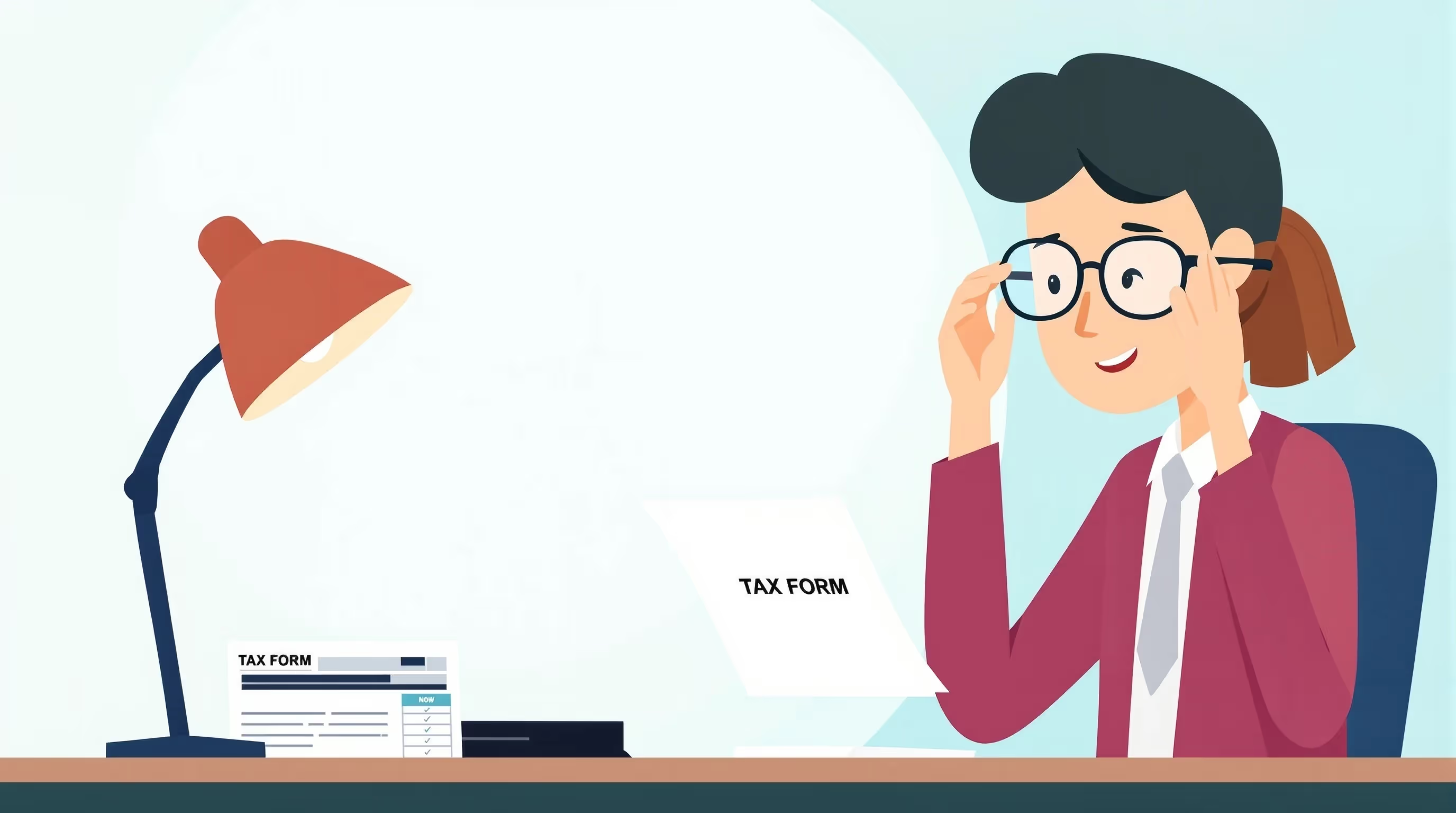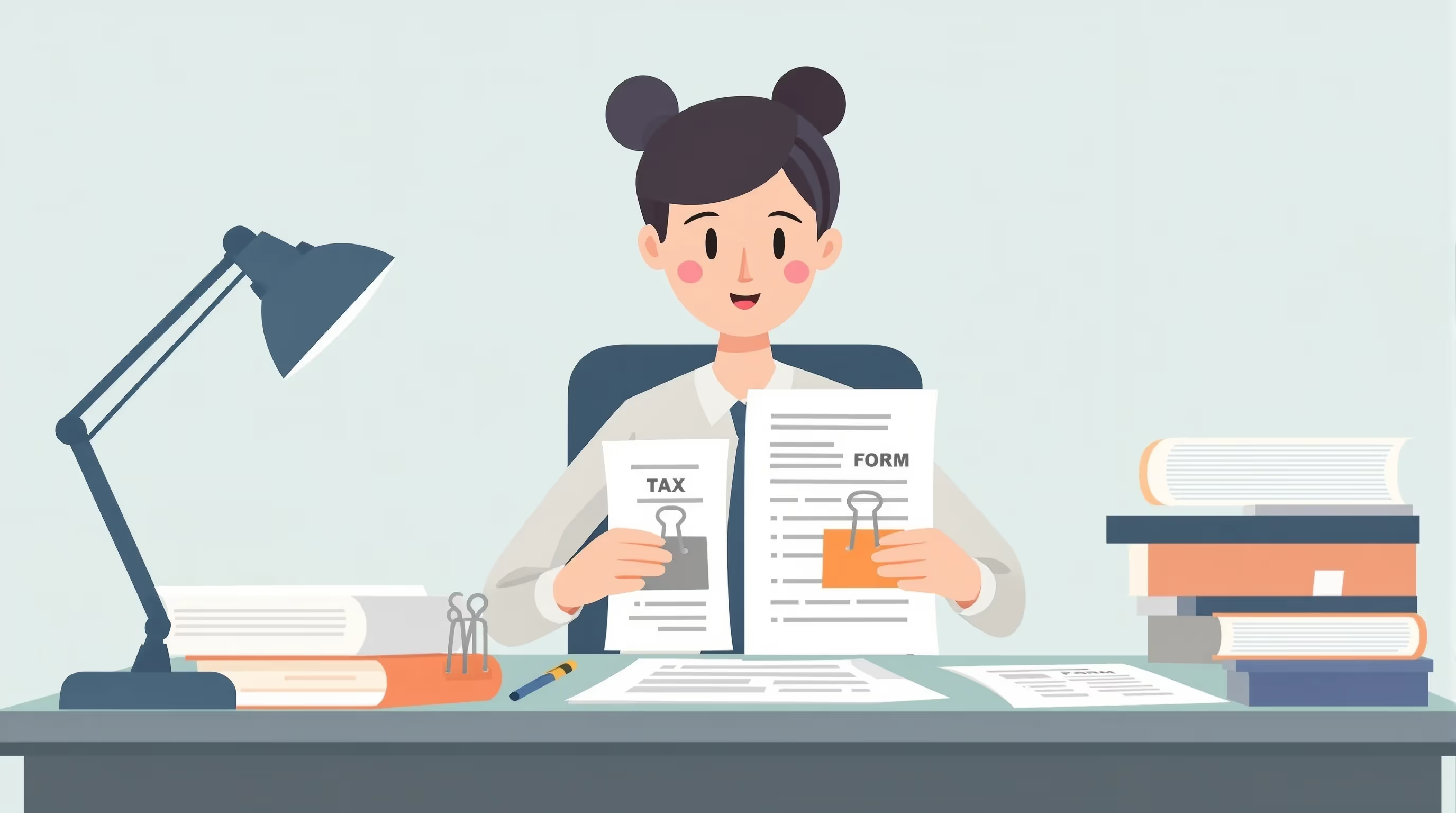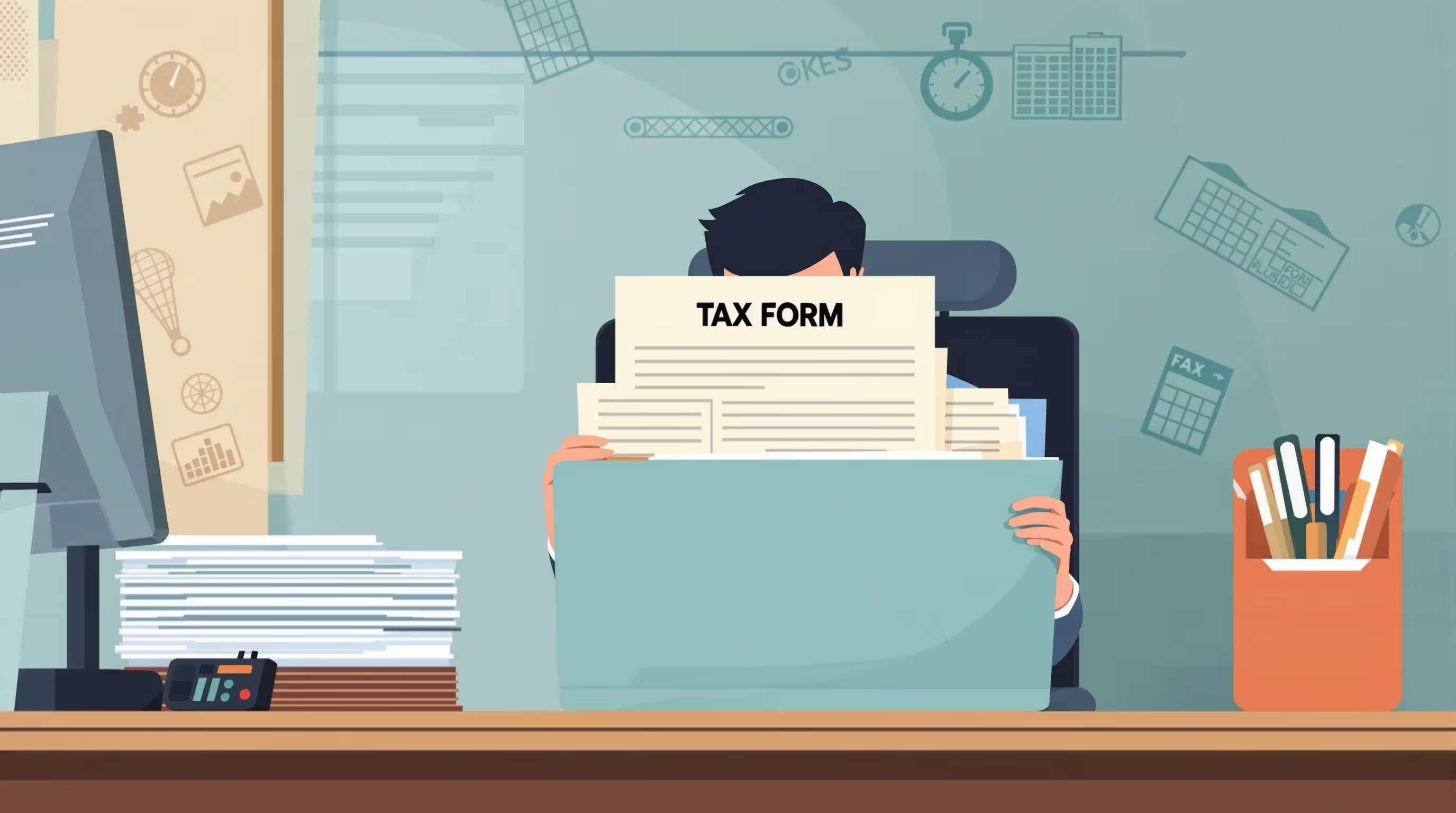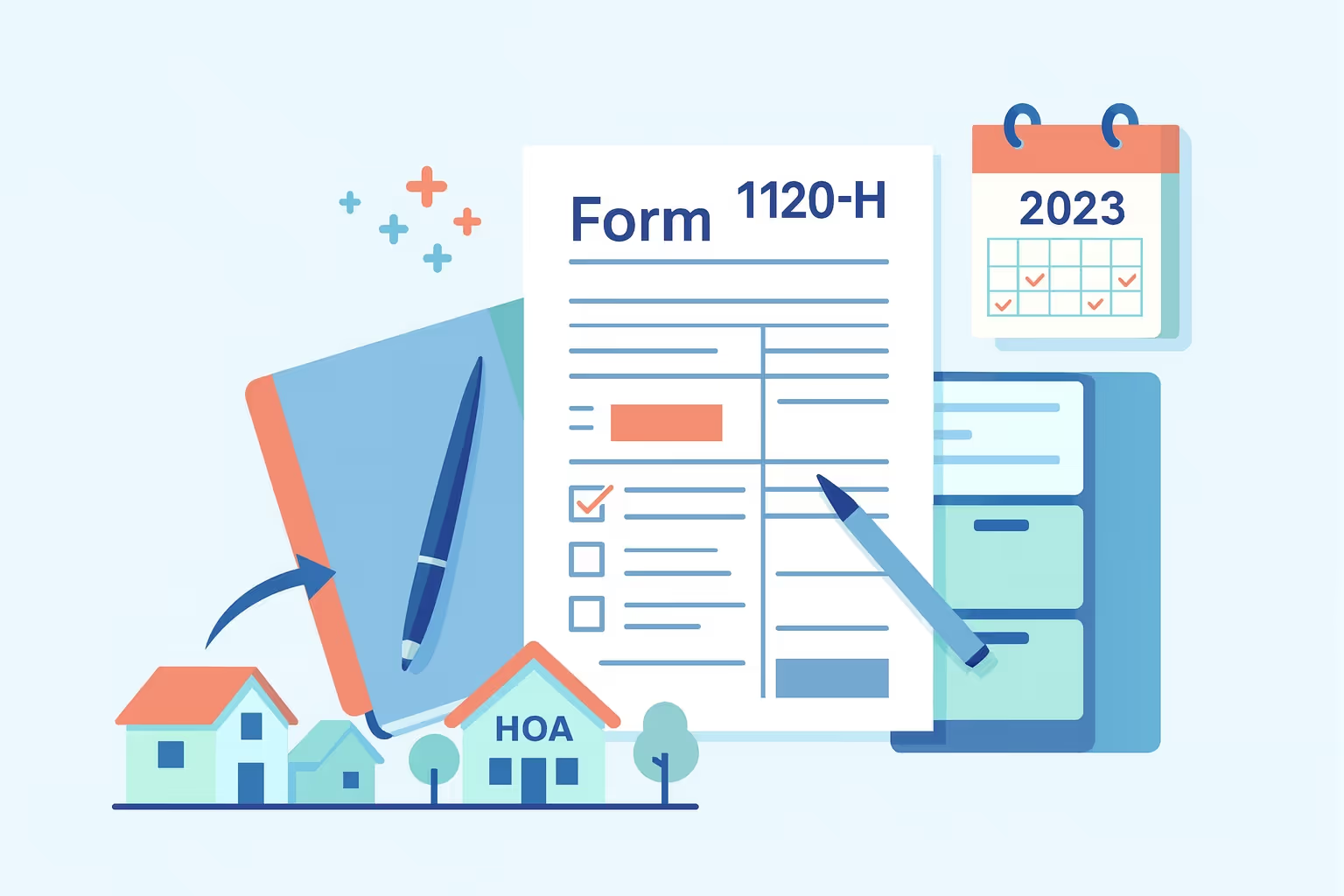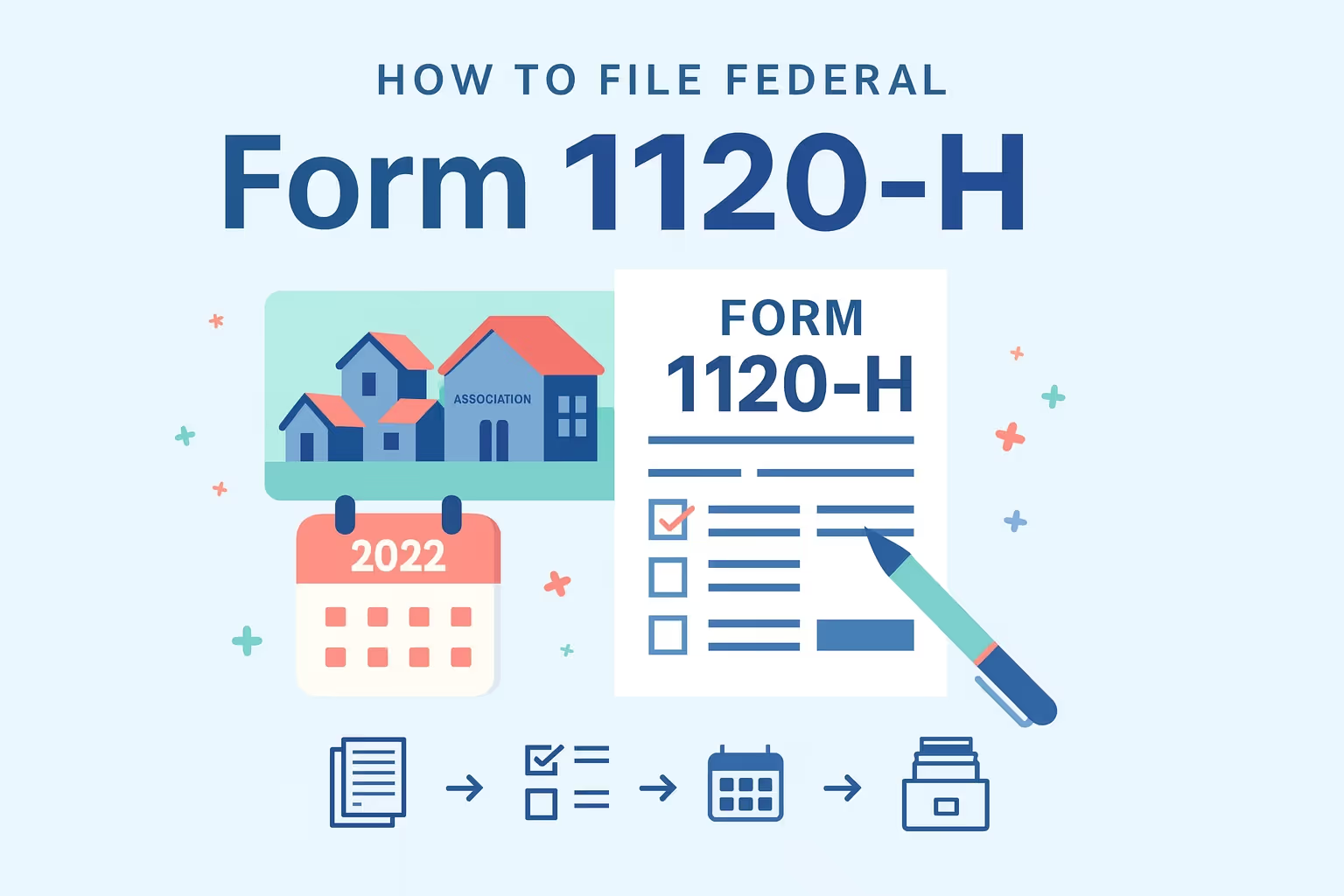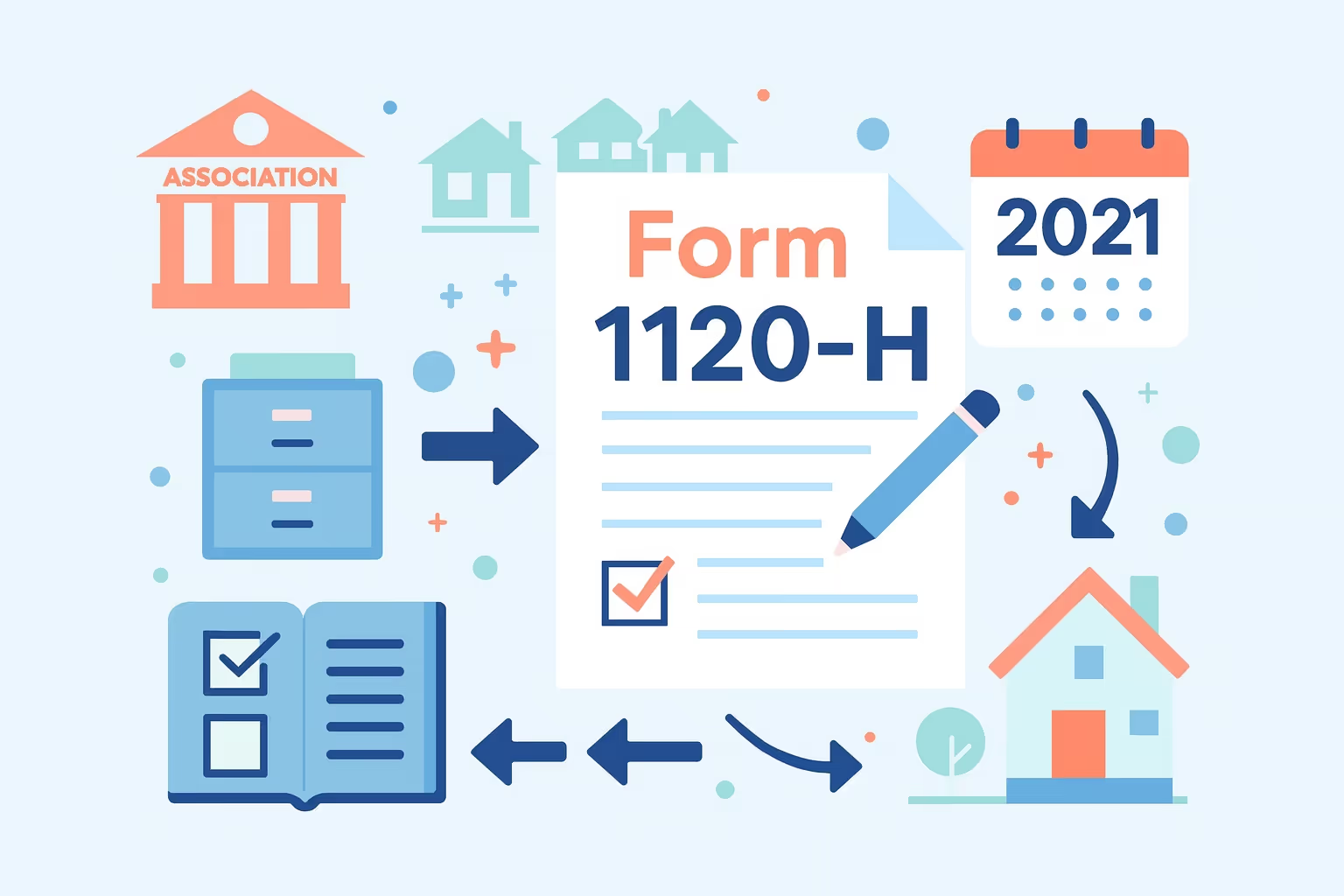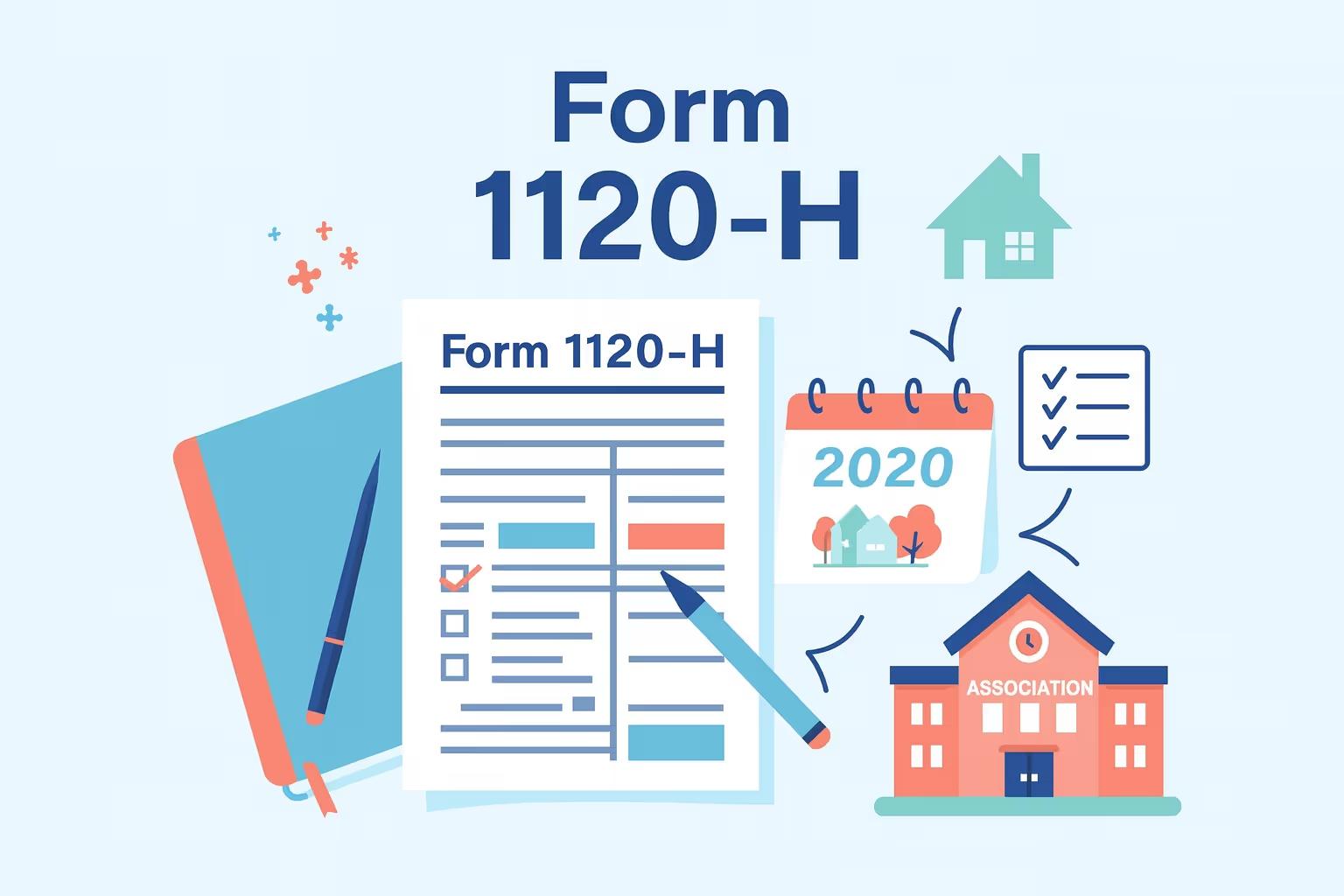Formulario 1120-H 2014: Instrucciones para asociaciones de propietarios
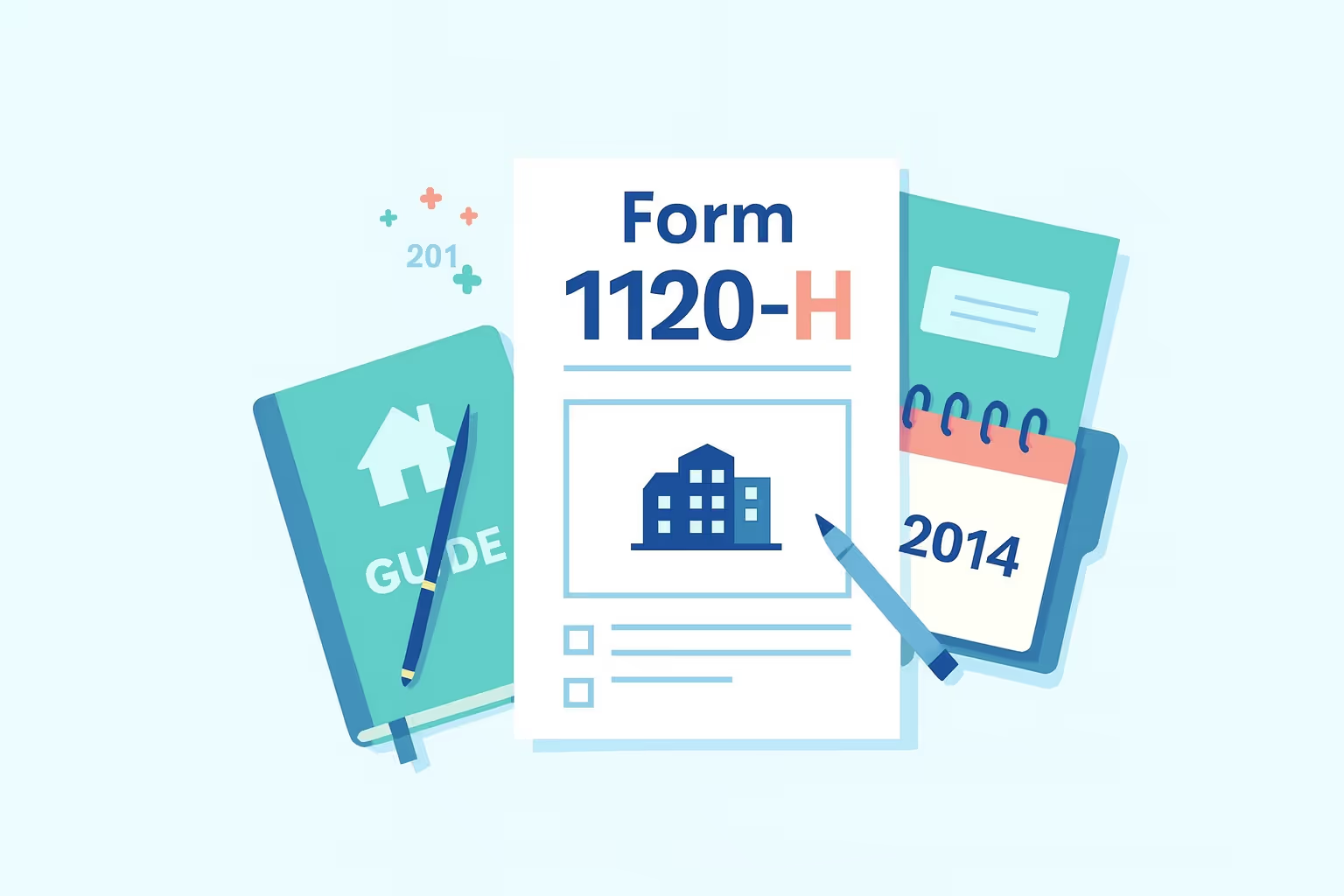
Presentar una declaración de impuestos precisa es esencial para todas las asociaciones de propietarios que buscan mantener la exención de impuestos y cumplir con los requisitos de la ley tributaria federal. Para el año tributario 2014, las organizaciones que reúnan los requisitos pueden usar el formulario 1120-H del IRS para simplificar el proceso de presentación de impuestos, solicitar ciertos beneficios tributarios y excluir los ingresos por funciones exentas de los ingresos brutos de su asociación. Esta opción de presentación está diseñada para asociaciones de administración de condominios, grupos de bienes raíces residenciales y organizaciones de tiempo compartido que reúnen los requisitos de conformidad con la sección 528 del Código de Impuestos Internos.
El Servicio de Impuestos Internos ofrece esta opción, que permite a las asociaciones calificadas pagar impuestos a una tasa fija del 30% o del 32% por tiempo compartido. Los ingresos por funciones exentas incluyen principalmente las cuotas de membresía, las tasaciones y los impuestos a la propiedad que se recaudan para mantener la propiedad de la asociación. Al cumplir con estos requisitos, las asociaciones pueden reducir la parte de los ingresos netos sujeta a impuestos. Las organizaciones que siguen las regulaciones del IRS, mantienen registros exhaustivos y documentan cada pago de impuestos fortalecen el cumplimiento y reducen el riesgo de saldos impagos.
Antes de iniciar la declaración, confirme que todas las cifras reflejen los ingresos y gastos de la asociación para el año calendario 2014. Según el Descripción general del formulario 1120-H del IRS, las asociaciones que reúnen los requisitos se benefician de un proceso de presentación de informes más sencillo que respalda la transparencia en la declaración de impuestos federales.
Comprensión de los ingresos exentos y los beneficios tributarios
Las asociaciones de propietarios de viviendas que reúnen los requisitos en virtud de la Sección 528 del Código de Impuestos Internos reciben beneficios tributarios específicos diseñados para apoyar la administración de la propiedad y el mantenimiento de la comunidad. Para acceder a estas ventajas, las asociaciones deben entender cómo funcionan los ingresos exentos para funciones en el marco de las leyes tributarias federales y cómo afectan directamente a los ingresos brutos de la asociación.
Los ingresos por funciones exentas consisten en los pagos recaudados a los miembros, incluidas las cuotas de membresía, las cuotas y las cuotas de membresía excedentes que se utilizan para mantener la propiedad de la asociación. La documentación adecuada de estos fondos ayuda a la organización a conservar su condición de entidad exenta de impuestos y a reducir la cantidad de impuestos adeudados sobre sus ingresos netos.
Las asociaciones deben entender cómo interactúan las categorías de gastos e ingresos según las regulaciones del IRS. Las organizaciones que reúnen los requisitos deben demostrar que al menos el 60% de sus ingresos brutos totales provienen de los ingresos por funciones exentas.
También deben asignar al menos el 90% de los gastos totales para mantener la propiedad de la asociación, pagar los impuestos inmobiliarios y cubrir los costos administrativos y de mantenimiento. Estos cálculos garantizan que la asociación de propietarios cumpla los requisitos para optar por el formulario 1120-H y pueda seguir excluyendo los ingresos por funciones exentos de la declaración de impuestos. El cumplimiento constante protege a la asociación de las obligaciones tributarias adicionales o de las auditorías provocadas por errores en la presentación de informes.
Ejemplos comunes de ingresos exentos y no exentos
- Los ingresos por funciones exentas consisten en cuotas de membresía, evaluaciones de impuestos a la propiedad, cuotas de membresía excesivas y pagos que se utilizan exclusivamente para mantener la propiedad de la asociación.
- Los ingresos no exentos consisten en los ingresos por intereses, los dividendos, las tarifas de alquiler, los cargos por uso de los huéspedes y los ingresos generados por fuentes ajenas a los miembros.
- El uso calificado significa asignar fondos para el mantenimiento de la comunidad, los impuestos inmobiliarios o las cuentas de reserva para mejoras de capital que se relacionan directamente con la propiedad común.
- El uso no calificado significa dirigir los pagos hacia actividades comerciales no relacionadas o gastos asociados con operaciones no residenciales.
Los registros financieros de la asociación deben separar claramente las fuentes de ingresos imponibles y exentas para mantener el cumplimiento de los requisitos del IRS. Cada pago debe incluir un propósito documentado que explique cómo los fondos apoyan las operaciones de la comunidad y el mantenimiento de la propiedad.
Estas clasificaciones proporcionan una base confiable para la presentación de informes precisos en virtud de las leyes tributarias federales, lo que garantiza que todos los ingresos imponibles se identifiquen correctamente. El Instrucciones del IRS para el formulario 1120-H (2014) describa cómo las asociaciones de propietarios de viviendas pueden calcular los ingresos por funciones exentas e informar los gastos que reúnan los requisitos para solicitar de manera efectiva ciertos beneficios fiscales.
Calcular los ingresos brutos y las deducciones de la asociación
Determinar el ingreso bruto de una asociación es una parte clave del proceso de presentación de impuestos para las organizaciones que utilizan el formulario 1120-H del IRS. Los ingresos brutos representan todos los ingresos imponibles que la asociación recibe durante el año tributario, excluyendo cualquier monto clasificado como ingreso por funciones exentas.
Cada asociación de propietarios debe identificar cada fuente de ingresos y confirmar si reúne los requisitos para la exclusión en virtud de las leyes tributarias federales. Mantener registros precisos garantiza que las cifras declaradas reflejen los ingresos de la asociación y cumplan con las regulaciones del IRS que rigen las declaraciones de impuestos de la HOA.
Definición del ingreso bruto de la asociación
Los ingresos brutos de una asociación incluyen todos los ingresos que no reúnen los requisitos para la exención en virtud de la Sección 528. Las categorías imponibles pueden consistir en los ingresos por intereses, los ingresos por alquileres de personas que no son miembros, los dividendos y otros ingresos no exentos. Los registros financieros deben distinguir claramente entre los ingresos imponibles y los exentos, indicando claramente el propósito y el origen de cada pago.
Explicación de las deducciones permitidas
Después de identificar el ingreso imponible total, las asociaciones pueden deducir los gastos directamente relacionados con la generación de esos ingresos. Las deducciones estándar incluyen los costos de mantenimiento de las actividades sujetas a impuestos, las comisiones de administración de propiedades, la depreciación de los bienes sujetos a impuestos y los impuestos inmobiliarios pagados en las áreas generadoras de ingresos.
Algunas organizaciones también pueden reunir los requisitos para recibir importantes créditos tributarios, como el crédito para viviendas para personas de bajos ingresos o el crédito para vehículos eléctricos calificados, si cumplen con los requisitos del Servicio de Impuestos Internos. Cada deducción o crédito debe incluir documentación que demuestre cómo el gasto contribuye a la presentación de informes precisos y al cumplimiento de las leyes tributarias federales.
El cálculo preciso de los ingresos brutos y las deducciones evita que la asociación de propietarios exagere los ingresos imponibles u omita las deducciones elegibles. También mejora la preparación para la auditoría al vincular claramente cada gasto con los ingresos que genera.
Cada cifra ingresada en el formulario 1120-H debe corresponder con la documentación original, lo que garantiza la precisión durante todo el proceso de presentación de impuestos. Una preparación minuciosa permite a las organizaciones verificar que sus ingresos netos totales, deducciones e impuestos adeudados se ajusten a los estándares del Servicio de Impuestos Internos para las entidades con sede en la comunidad.
Cómo elegir el formulario correcto del IRS para las declaraciones de impuestos de la HOA
Seleccionar el formulario correcto del IRS ayuda a la asociación de propietarios a declarar sus ingresos con precisión y a cumplir con las leyes tributarias federales. Las asociaciones que cumplen con los requisitos de elegibilidad de la Sección 528 suelen utilizar el formulario 1120-H para solicitar ciertos beneficios tributarios, excluir los ingresos por funciones exentos y simplificar el proceso de presentación de impuestos. Las organizaciones que no reúnan los requisitos deben presentar el formulario 1120, que sigue las normas tributarias corporativas estándar y los requisitos de presentación de informes por separado.
La decisión depende del porcentaje de ingresos que califique como exento y de si la mayoría de los gastos se utilizan para el mantenimiento de la propiedad asociado con la asociación. Cada opción de presentación influye en la tasa impositiva, las deducciones disponibles y las obligaciones de cumplimiento. Las asociaciones deben revisar ambos formularios anualmente para asegurarse de que sus declaraciones de impuestos federales reflejen con precisión la actividad financiera y el estado de elegibilidad.
Formulario 1120-H
- Elegibilidad: Disponible para asociaciones de administración de condominios, asociaciones de bienes raíces residenciales y organizaciones de tiempo compartido que cumplan con los 60% de ingresos y Gasto del 90% pruebas.
- Tasa impositiva: Tasa fija de 30% para asociaciones residenciales y 32% para asociaciones de tiempo compartido.
- Tratamiento de ingresos: Los ingresos por funciones exentas (por ejemplo, las cuotas de membresía, las cuotas y los impuestos a la propiedad para mantener la propiedad de la asociación) pueden excluirse de la renta imponible.
- Deducciones: Se limita a los gastos directamente relacionados con la generación de ingresos imponibles, como los ingresos por intereses y las actividades de los no miembros.
- Requisitos de cumplimiento tributario: Estructura de presentación simplificada con estándares de elegibilidad según la Sección 528.
- Mejor caso de uso: Cuando la mayoría de los ingresos califican como exentos y la asociación alcanza los umbrales de gastos.
Formulario 1120
- Elegibilidad: Se usa cuando una asociación de propietarios no pasa las pruebas de la Sección 528 o no califica para el estado de exención.
- Tasa impositiva: Sujeto a tasas impositivas corporativas graduadas según el nivel de ingresos.
- Tratamiento de ingresos: Debe incluir todos los ingresos, incluidos los ingresos por funciones exentas, en totales imponibles.
- Deducciones: Permite deducciones más amplias para gastos comerciales ordinarios y necesarios.
- Requisitos de cumplimiento tributario: Exige la presentación de informes corporativos completos según las leyes tributarias federales generales.
- Mejor caso de uso: Cuando los ingresos exentos son mínimos o la asociación no cumple con los requisitos de elegibilidad para el formulario 1120-H.
La comparación de estas opciones ayuda a la organización a presentar el formulario de impuestos correcto y a evitar futuros ajustes o impuestos impagos. Las asociaciones que no estén seguras sobre la elegibilidad o los cálculos de gastos deben consultar a un profesional tributario cualificado para confirmar cuál es el método de presentación que mejor contribuye al cumplimiento y a la presentación de informes precisos. Tomar una decisión informada cada año ayuda a la junta a mantener la transparencia, preservar su estado de exención de impuestos y cumplir con las regulaciones del IRS.
Requisitos de presentación, elegibilidad y regulaciones del IRS
Las asociaciones de propietarios de viviendas que presenten el formulario 1120-H del IRS primero deben confirmar que cumplen con los estándares de elegibilidad descritos en la Sección 528. Estos requisitos garantizan que las organizaciones reúnan los requisitos para recibir los beneficios tributarios diseñados para las asociaciones que mantienen la propiedad comunitaria y prestan servicios a sus miembros.
Cada condición de las leyes tributarias federales se centra en las fuentes de ingresos, los gastos y el propósito de la organización. El cumplimiento de estas reglas permite a la asociación excluir los ingresos por funciones exentas, mantener su condición de entidad exenta de impuestos y calcular las obligaciones tributarias con precisión de acuerdo con las regulaciones del Servicio de Impuestos Internos.
Las asociaciones deben demostrar que su estructura de ingresos se ajusta a las pruebas legales diseñadas para verificar las operaciones exentas. La prueba de ingresos brutos requiere que al menos el 60% de los ingresos totales de la asociación califiquen como exentos.
Además, la prueba de gastos exige que al menos el 90% del gasto total de la organización respalde directamente el mantenimiento de la propiedad de la asociación o la administración de las áreas comunes. Cada prueba garantiza que la asociación reúne los requisitos para acogerse a la tasa impositiva fija del 30 o el 32% y garantiza la conformidad con los requisitos del IRS para las entidades exentas. Documentar tanto los ingresos como los gastos en un formato claro y verificable es fundamental para el cumplimiento tributario y las auditorías futuras.
Requisitos básicos de presentación y elegibilidad
- Fuente de ingresos: Al menos el 60% de los ingresos brutos de la asociación deben ser ingresos por funciones exentos, como las cuotas de membresía, las cuotas y los impuestos a la propiedad que se calculan para el mantenimiento compartido.
- Asignación de gastos: Al menos el 90% de los gastos totales deben asignarse al mantenimiento de la propiedad de la asociación, a los impuestos inmobiliarios o a la administración de las instalaciones comunitarias.
- Propósito organizacional: La asociación debe operar exclusivamente en beneficio de los propietarios, centrándose en preservar el valor de las propiedades y administrar los servicios compartidos.
- Restricción de ingresos: Ninguna parte de las ganancias netas de la asociación puede beneficiar a particulares o accionistas.
- Mantenimiento de registros: Los estados financieros deben documentar claramente la clasificación de ingresos, los gastos, los pagos de impuestos estimados y cualquier impuesto sobre la renta retenido.
- Cumplimiento normativo: Las asociaciones deben cumplir con todas las regulaciones del IRS, presentar los formularios de impuestos correctos y cumplir con la fecha límite de presentación anual.
Se requiere un número de identificación del empleador válido y prácticas de presentación de informes consistentes para determinar la elegibilidad. Las asociaciones que no cumplan con estos criterios deben presentar en su lugar el formulario 1120, que las somete a las tasas impositivas corporativas estándar y elimina ciertas exenciones. La presentación correcta del formulario 1120-H garantiza que los ingresos por funciones exentos permanezcan excluidos y que todos los ingresos imponibles se declaren de manera transparente.
Una evaluación de elegibilidad precisa fomenta el cumplimiento a largo plazo de las leyes tributarias federales y protege a las asociaciones de deudas o disputas tributarias innecesarias. Las revisiones periódicas de las categorías de ingresos, las asignaciones de gastos y los procedimientos de presentación ayudan a mantener el cumplimiento. Las asociaciones que se mantienen diligentes en la aplicación de las regulaciones del IRS pueden conservar sus beneficios exentos de impuestos y, al mismo tiempo, cumplir con todas las obligaciones de presentación de informes.
Importancia de tener registros financieros precisos
Las asociaciones de propietarios de viviendas que presentan una declaración en virtud de la Sección 528 deben mantener registros financieros precisos y verificables para respaldar las declaraciones de impuestos y garantizar el cumplimiento de las leyes tributarias federales. La documentación detallada ayuda a clasificar los ingresos, hacer un seguimiento de los gastos y confirmar que los ingresos por funciones exentas se utilizaron adecuadamente para mantener la propiedad de la asociación. Un registro sólido reduce la probabilidad de que el IRS realice consultas, respalda la permanencia en la exención de impuestos y refuerza la responsabilidad financiera en cada período de presentación de informes.
Por qué los registros detallados son esenciales
- Demuestre el cumplimiento de las regulaciones del IRS mostrando cómo los ingresos por funciones exentas consisten en las cuotas de membresía, las tasaciones y los impuestos a la propiedad evaluados.
- Verifique que los ingresos y los gastos cumplan con las pruebas de calificación del 60 y el 90% según la Sección 528.
- Establezca la responsabilidad sobre cómo se asignaron los fondos para mantener la propiedad de la asociación, administrar las instalaciones compartidas y pagar los impuestos inmobiliarios.
- Proporcione un registro de auditoría confiable que confirme la exactitud de los impuestos sobre la renta retenidos declarados, los pagos de impuestos estimados y otras transacciones.
- Asegúrese de que los líderes de las asociaciones y los profesionales de impuestos puedan evaluar el desempeño financiero anual con total transparencia y precisión.
Qué deben rastrear las asociaciones
- Registros de ingresos: Documentación de todas las cuotas de membresía, cuotas, ingresos por intereses y otras fuentes de ingresos imponibles y exentos.
- Registros de gastos: Declaraciones detalladas que muestran los costos de reparaciones, mantenimiento, administración de propiedades y mejoras de capital.
- Documentación tributaria: Recibos y registros de los impuestos pagados, los impuestos adeudados y los pagos de impuestos estimados del año.
- Formularios de apoyo: Copias de declaraciones de impuestos anteriores, del formulario 1120-H del IRS actual y anexos que muestran los ingresos brutos y los gastos totales de la asociación.
- Estados de cuenta bancarios: Estados conciliados que confirman la precisión del flujo de caja y garantizan que todas las fuentes de ingresos se hayan registrado correctamente.
Mejores prácticas de mantenimiento de registros
- Mantenga los archivos organizados durante al menos tres años para cumplir con los estándares de retención de registros del IRS.
- Separe las categorías de ingresos exentos y no exentos en el sistema de contabilidad de la asociación.
- Revise los registros trimestralmente para identificar las discrepancias con anticipación y mantener informes precisos.
Los registros financieros precisos ayudan a la asociación a cumplir con los requisitos de presentación del IRS y demostrar un cumplimiento tributario total. Una organización coherente garantiza que los ingresos y los gastos permanezcan claramente definidos en cada ciclo de presentación de informes. La documentación confiable respalda la transparencia, protege la exención de impuestos de la asociación y fomenta la confianza en la gobernanza financiera.
Cómo completar y presentar el formulario 1120-H
La preparación y presentación del formulario 1120-H del IRS requiere prestar atención a los detalles y una comprensión clara de cada requisito de presentación de informes. Las asociaciones de propietarios deben proporcionar información precisa sobre sus ingresos, gastos y pagos de impuestos para garantizar el cumplimiento de las leyes tributarias federales. El proceso incluye varias secciones que abordan los datos de la organización, la clasificación de ingresos y las deducciones aplicables. Los pasos siguientes explican cómo completar el formulario correctamente y mantener la transparencia en cada entrada.
Paso 1: Verificar la elegibilidad
Confirme que la asociación de propietarios reúne los requisitos de la Sección 528. Para cumplir con los requisitos, al menos el 60% de los ingresos brutos de la asociación deben consistir en ingresos por funciones exentas, como las cuotas de membresía, las tasaciones y los impuestos sobre la propiedad que se cobran para mantener la propiedad de la asociación. Además, al menos el 90% de los gastos totales se debe utilizar para mantener las áreas comunes, pagar los impuestos inmobiliarios y administrar la propiedad compartida. Si no se cumple alguna de las dos pruebas, la organización debe presentar el formulario 1120 en lugar del formulario 1120-H.
Paso 2: Reúna toda la documentación requerida
Recopile los registros necesarios para completar el formulario con precisión. Estos incluyen los estados financieros, los estados bancarios, los anexos justificativos y las declaraciones de impuestos del año anterior. Cada documento debe confirmar los ingresos, gastos e impuestos de la asociación pagados durante el año fiscal 2014. La documentación organizada respalda el cumplimiento del IRS y simplifica la verificación durante las auditorías o revisiones.
Paso 3: Complete la sección de encabezado
Introduzca el nombre legal, la dirección y el número de identificación del empleador de la asociación. Seleccione el tipo de asociación correcto: asociación de administración de condominios, asociación de bienes raíces residenciales o asociación de tiempo compartido. Marque las casillas correspondientes para el cambio de nombre, el cambio de dirección o la declaración modificada. Confirme que el año tributario que finaliza el 31 de diciembre de 2014 aparezca correctamente.
Paso 4: Complete los elementos de la A a la E
Proporcione detalles relacionados con el tipo de asociación, las pruebas de ingresos brutos, los gastos totales y los intereses exentos de impuestos recibidos. Cada elemento valida que la organización cumple con los requisitos de la Sección 528. Asegúrese de que las cifras coincidan con los registros financieros e incluya cronogramas justificativos cuando sea necesario.
Paso 5: Reporte los ingresos en las líneas 1 a 8
Enumere todas las fuentes de ingresos imponibles, incluidos los ingresos por intereses, los dividendos, las cuotas de los no miembros y las ganancias por la venta de propiedades. No incluya los ingresos por funciones exentas en estos totales. Sume todos los montos para determinar el ingreso imponible total.
Paso 6: Ingresa las deducciones en las líneas 9 a 18
Registre los gastos deducibles directamente relacionados con la generación de ingresos imponibles, como los costos de mantenimiento, las comisiones de administración, la depreciación y los impuestos sobre bienes inmuebles pagados por la propiedad sujeta a impuestos. Reste las deducciones totales del ingreso imponible bruto para calcular el ingreso imponible neto.
Paso 7: Calcule los impuestos y los pagos en las líneas 19 a 26
Aplica la tasa del 30% para asociaciones de condominios o residenciales o la tasa del 32% para asociaciones de tiempo compartido. Incluya el impuesto sobre la renta retenido, los pagos de impuestos estimados y cualquier crédito disponible. Calcule el impuesto total adeudado o el sobrepago.
Paso 8: revisar, firmar y archivar
Verifique que todas las entradas sean correctas y concuerden con la documentación de respaldo. Firme y feche la declaración antes de enviarla. Guarde copias del formulario completo y de los registros justificativos durante al menos tres años.
El Descargar el formulario 1120-H (2014) La página proporciona el formulario oficial requerido para la presentación. Seguir cada paso garantiza la precisión de los informes, el cumplimiento de las regulaciones del IRS y la elegibilidad continua para la exención de impuestos. Una preparación cuidadosa genera confianza en cada presentación y ayuda a las asociaciones a mantener una alineación total con las leyes tributarias federales.
Consejos sobre la fecha límite de presentación, el pago y el cumplimiento tributario
Cumplir con la fecha límite de presentación y completar los pagos requeridos garantiza que las asociaciones de propietarios sigan cumpliendo con las leyes tributarias federales. El formulario 1120-H del IRS debe completarse con precisión, estar respaldado por registros verificados y presentarse a tiempo para evitar obligaciones tributarias o intereses adicionales. Comprender las fechas de vencimiento clave, los métodos de pago y las estrategias de cumplimiento ayuda a las organizaciones a administrar los informes anuales de manera efectiva.
Fecha límite de presentación
- Fecha límite: La fecha límite de presentación para el año tributario 2014 es el 15 de marzo de 2015, que es el día 15 del tercer mes siguiente al final del año tributario.
- Opción de extensión: Las asociaciones pueden solicitar una prórroga de seis meses mediante el formulario 7004, que extiende la fecha límite hasta el 15 de septiembre de 2015.
- Obligación de pago: Las extensiones de presentación se aplican solo al envío del formulario y los pagos de impuestos no deben demorarse. Todos los impuestos adeudados deben pagarse antes de la fecha de vencimiento original para evitar la acumulación de intereses.
Métodos de pago
- Sistema electrónico de pago de impuestos federales (EFTPS): Las asociaciones pueden programar y pagar los impuestos federales electrónicamente mediante el EFTPS, un servicio seguro que admite transacciones con fecha futura.
- Transferencia bancaria el mismo día: Las organizaciones pueden coordinarse con sus instituciones financieras para procesar los pagos de impuestos el mismo día en plazos urgentes.
- Cheque o giro postal enviado por correo: Las personas que declaran en papel pueden enviar los pagos por separado de la declaración para garantizar un procesamiento preciso y un seguimiento del registro.
- Pagos de impuestos estimados: Las asociaciones que esperan adeudar impuestos importantes pueden presentar pagos de impuestos estimados a lo largo del año para evitar cargos por pago insuficiente.
Consejos de cumplimiento tributario
- Mantenga registros detallados: Guarde la documentación que muestre la clasificación de ingresos, los ingresos brutos de la asociación, los impuestos pagados y el pago imponible neto total del año del informe.
- Supervise los cambios en las leyes tributarias: Manténgase informado de las actualizaciones del IRS que pueden afectar las declaraciones de impuestos de la HOA, las deducciones elegibles o los beneficios tributarios.
- Confirme el estado de exención de impuestos: Revise los criterios de la Sección 528 anualmente para verificar la calificación continua para las exclusiones de ingresos por funciones exentas.
- Contrate a un profesional de impuestos: Trabaje con un profesional de impuestos con licencia para confirmar el cumplimiento, revisar las deducciones y presentar formularios de impuestos precisos.
- Preparación para la auditoría: Mantenga registros financieros completos, incluidos los impuestos sobre la renta retenidos, los gastos y los pagos, para abordar posibles consultas del IRS.
La presentación oportuna, los pagos precisos y el cumplimiento de las regulaciones del IRS generan confianza en las prácticas financieras de la asociación. El mantenimiento de registros organizados y un cumplimiento constante protege los ingresos de los funcionarios exentos, garantiza que se liquiden todos los impuestos adeudados y respalda la elegibilidad continua para recibir los beneficios tributarios de las asociaciones de propietarios.
Preguntas frecuentes
¿Qué son los ingresos por funciones exentas y cómo afectan a la declaración de impuestos sobre la renta de una HOA?
Los ingresos por funciones exentas incluyen las cuotas de los miembros, las cuotas y los pagos utilizados para mantener la propiedad de la asociación. Estos ingresos se excluyen de los ingresos imponibles al presentar una declaración de impuestos sobre la renta de la HOA en virtud de la Sección 528. Para reunir los requisitos, al menos el 60% de los ingresos brutos de la asociación deben provenir de estas fuentes exentas, y el 90% del gasto total debe destinarse a las operaciones de la comunidad. La clasificación precisa garantiza el cumplimiento y preserva la elegibilidad para obtener tasas impositivas favorables.
¿En qué se diferencia el formulario 1120-H de una declaración de impuestos sobre la renta de sociedades?
El formulario 1120-H está diseñado para las asociaciones de propietarios que reúnen los requisitos para recibir un tratamiento exento de impuestos en virtud de la Sección 528, ya que permite excluir los ingresos por funciones exentos y una tarifa fija del 30 o el 32%. La declaración del impuesto sobre la renta de sociedades (formulario 1120) sigue los tramos impositivos corporativos estándar y se aplica cuando una asociación no pasa las pruebas de elegibilidad. La selección del formulario correcto depende de la composición de los ingresos, los gastos totales de la asociación y el uso previsto de las contribuciones de los miembros.
¿Cuándo debe una asociación de propietarios presentar las declaraciones de impuestos federales?
Una HOA debe presentar las declaraciones de impuestos federales antes del día 15 del tercer mes siguiente al cierre del año tributario de su asociación, generalmente el 15 de marzo. Las prórrogas de hasta seis meses están disponibles a través del formulario 7004, siempre que los impuestos adeudados se paguen antes de la fecha de vencimiento original. La presentación oportuna demuestra el cumplimiento, ayuda a evitar intereses sobre los montos impagos y mantiene la posición de la asociación en virtud de las leyes tributarias federales.
¿Pueden las asociaciones de propietarios solicitar deducciones o créditos tributarios?
Las asociaciones de propietarios pueden reunir los requisitos para recibir créditos tributarios limitados si cumplen con los criterios federales de elegibilidad. Los créditos más comunes incluyen incentivos para la eficiencia energética, mientras que las deducciones se aplican a los gastos directamente relacionados con las actividades sujetas a impuestos, como los ingresos por alquileres o las ganancias por inversiones. Las asociaciones no pueden deducir los costos financiados con ingresos por funciones exentas. La documentación adecuada y el cumplimiento de las directrices del IRS ayudan a garantizar que los créditos y deducciones tributarios reclamados se ajusten a los requisitos de presentación de informes y a los beneficios disponibles.
¿Las HOA están obligadas a presentar una declaración estatal de impuestos sobre la renta?
Muchos estados exigen que las asociaciones de propietarios presenten una declaración estatal de impuestos sobre la renta además de su presentación federal. Los requisitos varían según las leyes tributarias del estado, los umbrales de presentación y el reconocimiento de los ingresos por funciones exentos. Las asociaciones deben verificar las obligaciones locales, hacer un seguimiento de los cambios en la legislación tributaria y asegurarse de que las presentaciones federales y estatales cumplan con estos requisitos. Los servicios tributarios profesionales de consultoría pueden ayudar a gestionar los plazos y garantizar el cumplimiento efectivo en varios niveles.
¿Cómo debe informar una HOA las ganancias de capital y los ingresos por alquiler?
Las asociaciones de propietarios deben incluir las ganancias de capital y los ingresos por alquiler de fuentes no miembros como ingresos imponibles en el formulario 1120-H. Estas ganancias no califican como ingresos por funciones exentas porque provienen de actividades comerciales. Los documentos de respaldo deben mostrar las fechas de adquisición, los precios de venta y los gastos relacionados. La presentación correcta de estas cifras garantiza una obligación tributaria precisa y alinea la declaración con los requisitos del IRS para las asociaciones que realizan transacciones sujetas a impuestos.
¿Las HOA pueden usar un acuerdo de pago a plazos en línea para saldos impagos?
Sí, las asociaciones que adeudan impuestos adicionales después de presentar su declaración pueden solicitar un acuerdo de pago a plazos en línea a través del sitio web del IRS. Este acuerdo permite pagar mensualmente los saldos pendientes, lo que minimiza el riesgo de que se tomen medidas coercitivas. Antes de presentar la solicitud, la asociación debe confirmar que se han presentado todas las declaraciones de impuestos federales anteriores y que los montos totales adeudados se declaran con precisión. Los arreglos oportunos promueven el cumplimiento y mantienen una buena reputación con el IRS.






